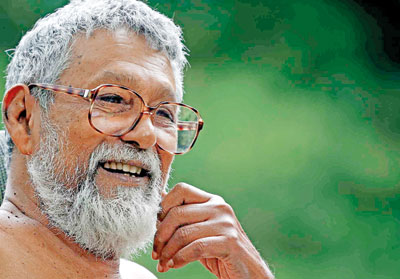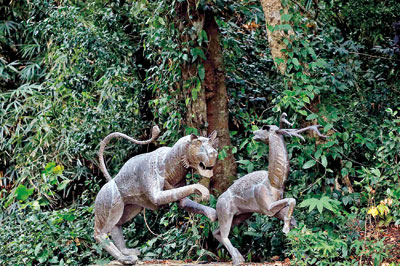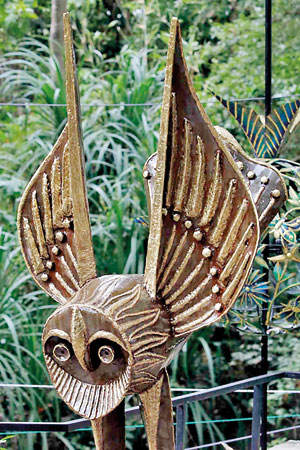Laki as I knew him
 I am confident that there will be a fair share of obituaries and appreciations of Laki Senanayake that will attempt to capture something of the man and his work. This is a more personal account of my encounters with Laki, which span over half a century.
I am confident that there will be a fair share of obituaries and appreciations of Laki Senanayake that will attempt to capture something of the man and his work. This is a more personal account of my encounters with Laki, which span over half a century.
Although Laki and I first met at school at Royal College, it was as young adults that we became friends, travel companions and later colleagues on a succession of work assignments and passion projects. We often painted together and worked together on architectural projects. We dipped our fingers in dye baths to produce batik wall hangings. We hammered sculptures out of aluminum sheeting and applied gold leaf on mural paintings. We had a shared passion for birdwatching and escaped to remote lagoons, scanning the horizon for rare migrant birds that were wintering in Sri Lankan wetlands.
He was a friend I shared with my family, particularly my brothers, Jehan and Omar, and sisters, Yasmin and Ryhana, and together we went on many trips, sometimes 16 of us crammed in a jeep with provisions for a two-night stay (his daughter Mintaka, just a toddler, accompanied us on these trips). On my return from Copenhagen in 1969, it was Laki, ever gracious, who in March of that year threw a party at his home to celebrate my marriage to my wife Delini. With the passing of time, the trajectories of our lives diverged and Laki and I were no longer in frequent contact. But our overlapping interests and passions meant that whenever we did meet, we could very easily reconnect. During this time, it was Delini who kept in touch with Laki and invited him home for birthday celebrations and the family Christmas lunch.
 During his time at Royal College, Laki was a well-known figure. He was a good swimmer and an excellent springboard diver. Even in those early days he was a free spirit and not afraid to speak his mind. On one occasion, he had an altercation with a classmate, and the principal took the somewhat unorthodox step of setting up a boxing match to resolve the issue; Laki beat the daylights out of his opponent and the match had to be stopped. Although, most of us schoolboys did not follow politics, we knew of his mother Florence Senanayake’s political achievements. In 1947, soon after Laki’s father’s death, Mrs Senanayake contested in the first Sri Lankan parliamentary elections and was elected as the only female MP, representing the Kiriella seat for the Lanka Sama Samaja Party.
During his time at Royal College, Laki was a well-known figure. He was a good swimmer and an excellent springboard diver. Even in those early days he was a free spirit and not afraid to speak his mind. On one occasion, he had an altercation with a classmate, and the principal took the somewhat unorthodox step of setting up a boxing match to resolve the issue; Laki beat the daylights out of his opponent and the match had to be stopped. Although, most of us schoolboys did not follow politics, we knew of his mother Florence Senanayake’s political achievements. In 1947, soon after Laki’s father’s death, Mrs Senanayake contested in the first Sri Lankan parliamentary elections and was elected as the only female MP, representing the Kiriella seat for the Lanka Sama Samaja Party.
Laki was quite fearless. Out of school in the 1960s, he became an avowed motorcycle fanatic and became adept at riding a 1,500cc bike, at the time the most powerful machine on two wheels in the country. Competing in an all-island motor rally in 1968, he won first place after completing a journey that covered hundreds of miles and traversed the country’s steepest roads. As members of the so-called Diving Suicide Squad of the Otters Swimming Club, Laki and my brother Omar performed various daredevil feats, such as diving through flaming hoops.
The first meaningful encounter that Laki and I had at school was at the annual arts, crafts, hobbies and science exhibition in July 1955, where we were both exhibiting our work. Laki was then 18 and I was 14. This was an important moment for us both because our exhibits were subsequently selected for a special exhibition held under the auspices of UNESCO in Paris in 1958. We reconnected after I left school in 1960, when we were both working as architectural draughtsmen at the firm of Peiris & Billimoria. After a short stint there, Laki moved on to join the architectural firm of Edwards, Reid & Begg (ERB), and I followed him there later. 
ERB was to become synonymous with the unique design style developed by the architects Geoffrey Bawa and Ulrik Plesner. It was here, encouraged and mentored by Bawa and Plesner that Laki blossomed and truly came into his own as a young architect and artist. A little-known fact about Laki is that as both an artist and an architect, he was largely self-taught. This is unique. Most other architects of the time, myself included, were products of architectural schools, such as the AA School in London or the Royal Danish Academy in Copenhagen. Laki, in contrast, never followed any structured, formal course of study and saw conventional education as having little to recommend (in) it.
Although most people will remember Laki as an artist, he was also an architect, whose working life unfolded during a significant moment in the development of Sri Lankan architecture. He worked with a coterie of architects who pioneered the modern movement in architecture in this country. This closely-knit group importantly included Geoffrey Bawa, Ulrik Plesner, Nihal Amarasinghe and Turner Wickramasinghe.
Laki was employed by Bawa’s office on a flexible arrangement: he sometimes worked as an assistant architect, but most of the time he was employed as an artist and sculptor. He was effectively the lynchpin in the design team in the ERB office. As such, he played a crucial role in the design of several key projects, including the Ena de Silva residence in Colombo, Ash de Silva’s house in Galle and the Chapel for the Good Shepherd Convent, Bandarawela; the first two were designed by Bawa and the last by Plesner. Laki’s stamp was also evident in several other projects undertaken by ERB during the 1970s. As one of Bawa’s chief confidantes, he played a range of different roles in many of the practice’s projects until about 1990.
During the years Laki and I worked for Geoffrey Bawa, we would often spend long weekends at Lunuganga, Bawa’s residence near Bentota; our time-off from work was spent documenting the trees and birds that inhabited the garden and these details would later be dutifully recorded in the Geoffrey’s visitors’ book. Laki and I were also privileged to be part of a small architectural heritage group formed by Plesner and including Barbara Sansoni; our aim was to document a series of 18th–19th century buildings that were both religious and secular, and often threatened by demolition and development. Over a two-year period, we surveyed over 25 buildings, making careful measured drawings and taking copious notes. Underpinning this work was a desire to understand the essence of the vernacular architectural traditions of Sri Lanka; vernacular architecture was identified as a solution to the architectural dilemma of a country emerging from colonialism and trying to assert an identity that was both indigenous and modern.
Laki played an influential role in my development as an artist. It was probably in 1960 that Laki, I and a few others founded the Young Artist Group (YAG). The trustees of the Lionel Wendt allocated a room in the theatre premises as the group’s studio. While Laki played a pivotal role in organizing the annual YAG exhibitions that were held from 1960–65, he encouraged me to undertake the task of designing the invitation cards and catalogue.
By 1961, I was creating large-scale batik wall hangings at Ena de Silva’s workshops at No. 5 Alfred Place in Colombo. The intricate technique of batik was first explained to me by both Laki and Ena, who was his partner in the batik venture. A few years later in 1967, I paid my debt to both Ena and Laki by organizing a very first international exhibition for their firm in Copenhagen, while I was pursuing a post-graduate course in architecture at the Royal Danish Academy.
The work I did as an artist with Laki involved experimenting with and mastering a range of traditional and new approaches and techniques; these ranged from water colour painting and pen and ink drawing to working with different materials, such as paper and textiles, and sculptures in wood, aluminum and copper. It was fascinating to see how Laki continually experimented with different artistic media and this, in turn, inspired me to experiment. When the Australian artist Donald Friend visited Sri Lanka in 1972, Laki and I had the opportunity to see him at work, as the artist was a friend of both Geoffrey Bawa and his brother, Bevis. Laki and I were fascinated by Friend’s technique of drawing in the pen-and-ink medium and we each developed a distinctive style that drew heavily from it.
In the late 1970s, before I decided to establish my own architectural practice, Laki and I would regularly meet, travel or work together at his home on the edge of Muthurajawela and later at the haven he created in Diyabubula near Dambulla. I continued to follow and be inspired by his work as an artist. Of his large body of work, I particularly admire the designs he did for the currency notes that were issued by the Central Bank in 1979. Laki was determined to base these on a natural history theme, specifically the endemic flora and fauna unique to Sri Lanka, so turned up at my then home at Clifford Road, Colpetty, to access my collection of 19th century natural history books. I helped locate some of the illustrations he used as reference material, and he cleverly incorporated them into the designs in his distinctive style. Laki’s currency notes went on to win a major international design prize and, for a time, images of the twenty-rupee note adorned the walls of a Paris Metro station.
In a country where people often take themselves far too seriously, Laki had a mischievous sense of humour and a permanent twinkle in his eye. He was also a master of disguise, a skill that I believe he inherited from his father, Reginald S. Vincent Senanayake, who is said to have fled incognito to India to avoid being arrested as a Trotskyite by the British colonial administration. From time-to-time Laki would turn up at our workplace or homes in disguise, adopting the character of an uncouth and morose person. On one memorable occasion, he pulled this stunt at one of Ena de Silva’s batik sales at her residence in Alfred Place, upbraiding the cashier, Phyllis (Ena‘s sister), for the exorbitant cost of the batiks and for deceiving the public. After much pandemonium and consternation, Laki removed his disguise and it all ended in good humour.
To me, Laki was far more than a friend, he was also my teacher, mentor and fellow explorer. His death is a great loss and he will be sorely missed.


